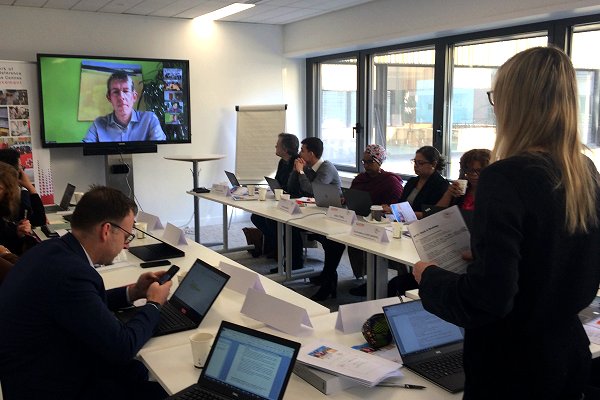
‘Meeting without flying’: Beat coronavirus reduce your carbon footprint

There are now not one but two very compelling reasons to “fly less”, as the new wisdom is handily summed up: the estimated 2 per cent of all carbon emissions generated by aviation, and the relatively sudden-onset global emergency of coronavirus. (And not necessarily in that order.)
There’s a discussion underway in the media and elsewhere about whether the expanding travel bans and lockdowns related to the virus may lead to what MIT Technology Review writer James Temple describes as “long-lasting shifts in carbon-intensive behaviours, if people remain fearful of flying and cruise ships, or come to prefer remote working and virtual conferences.”
We’ll see; it’s surely a possibility. Coronavirus and climate may together dominate enough of the timeline of mass attention to bring about just such long-term behaviour change.
But in the meantime we at the Climate Centre, together with our colleagues at the IFRC secretariat, are offering our experience with all things virtual to assist the drive to fly less – in fact, not to fly at all!
Many agencies have now banned all but emergency foreign travel. But we cannot just put our humanitarian mission on hold – including, of course, our own response to coronavirus and still-critical efforts to step up action in response to the climate emergency.
We hope that part of the answer on how to operate and confer effectively in what may become the stay-home age is contained in our Virtually Amazing Manifesto, launched today in Geneva and The Hague.
Can we design events that enable
meaningful participation at a distance,
reducing health risks and costs? (Yes)
For obvious reasons our expert Climate Centre team have for some time now been trying to cut down the amount of time we spend in the air, and with that our own personal footprints.
But largely thanks to the pioneering work of our Associate Director for Research and Innovation, Pablo Suarez, my centre now aims to become a leading torchbearer for “interactive, meaningful, effective virtual engagements,” as the manifesto puts it.
“Can we design and facilitate events that enable meaningful participation at a distance, reducing health risks – and costs – while taking advantage of all the possibilities offered by digital technologies?” it asks.
Well, yes, we can, by becoming “virtually amazing” and reimagining all that we can accomplish when liberated from the expectation of having to be physically under the same roof.
Building on the Climate Centre’s experience with games, improvisation, humour and other outwardly unconventional ways of stimulating the interest of participants, we have tried to redefine how digital platforms can bridge people and teams across continents and time zones.
They may be about to become a whole lot less unconventional!
Technical platforms
Face-to-face engagement will always have its place; in the context of sensitive, high-level negotiations in which every human nuance may carry meaning, for example.
But if you think about the typical conference PowerPoint, presented in person by a delegate clicking from slide to slide, how much difference does it really make if the presenter is also on the screen and actually thousands of miles away?
Now imagine what our manifesto calls a “carefully designed sequence of events including interactions, discussion prompts, breakout rooms, interactive question and response, creative spaces,” all coordinated remotely, and the need to board an aircraft begins to fade.
Clearly most events will need a physical hub somewhere, but the number of people who need to be physically – as opposed to virtually – present is surely going to get smaller and smaller.
To assist locations with low bandwidth and connectivity, the Climate Centre is exploring a range of technical platforms with different requirements, as well as opportunities to set up humanitarian virtual-hubs in the offices of partners such as development ministries, the World Bank, the World Food Programme (with forecast-based financing) and many others.
Risks
But to end on a very serious note, and for the avoidance of doubt. No one in the climate sector is welcoming the reduction in emissions brought about by coronavirus restrictions for itself.
James Temple wisely quotes Professor Gernot Wagner at New York University’s Department of Environmental Studies as saying that most of the current coronavirus-centred risks run against progress on climate change and urging caution in drawing “larger lessons”.
“Emissions in China are down because the economy has stopped and people are dying, and because poor people are not able to get medicine and food,” Wagner told MIT Technology Review. “This is not an analogy for how we want to decrease emissions…”. We agree 101%.
Climate Centre Director Professor Maarten van Aalst virtually joins other researchers and experts from the Red Cross Red Crescent Movement for a meeting on global humanitarian research initiatives last week at the French Red Cross. (Photo: Julien Antouly/Fondation Croix Rouge via Twitter)